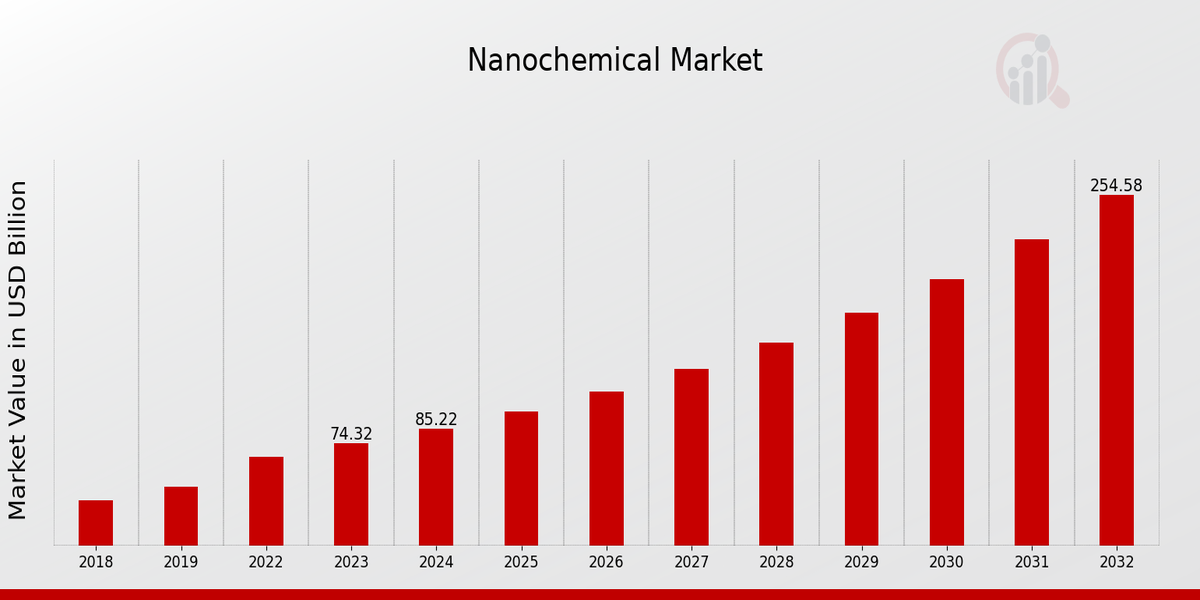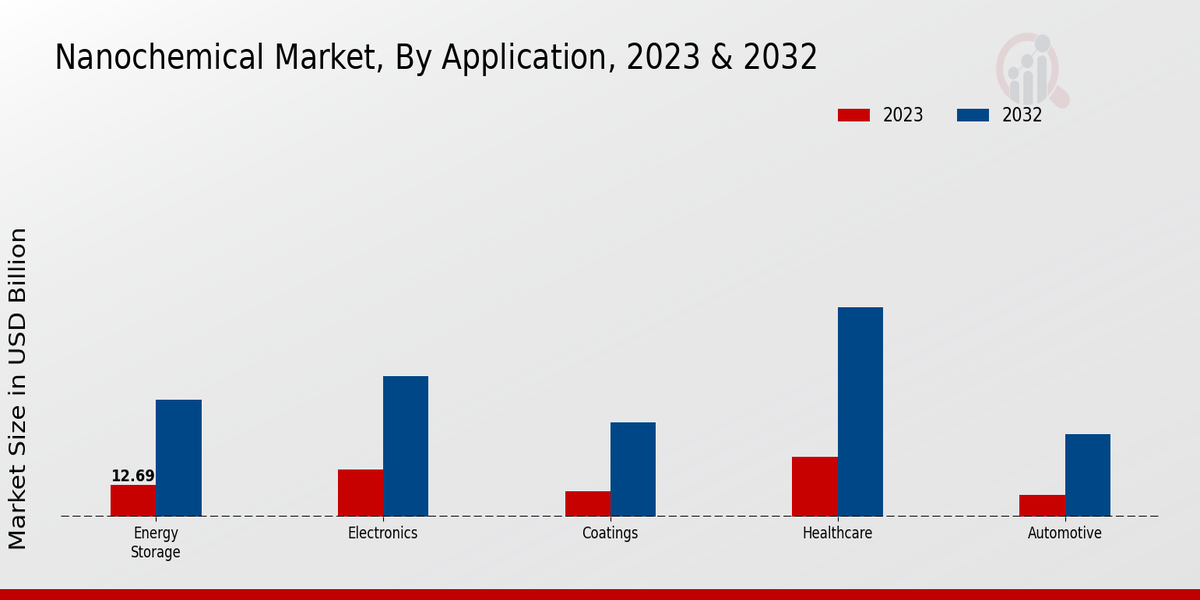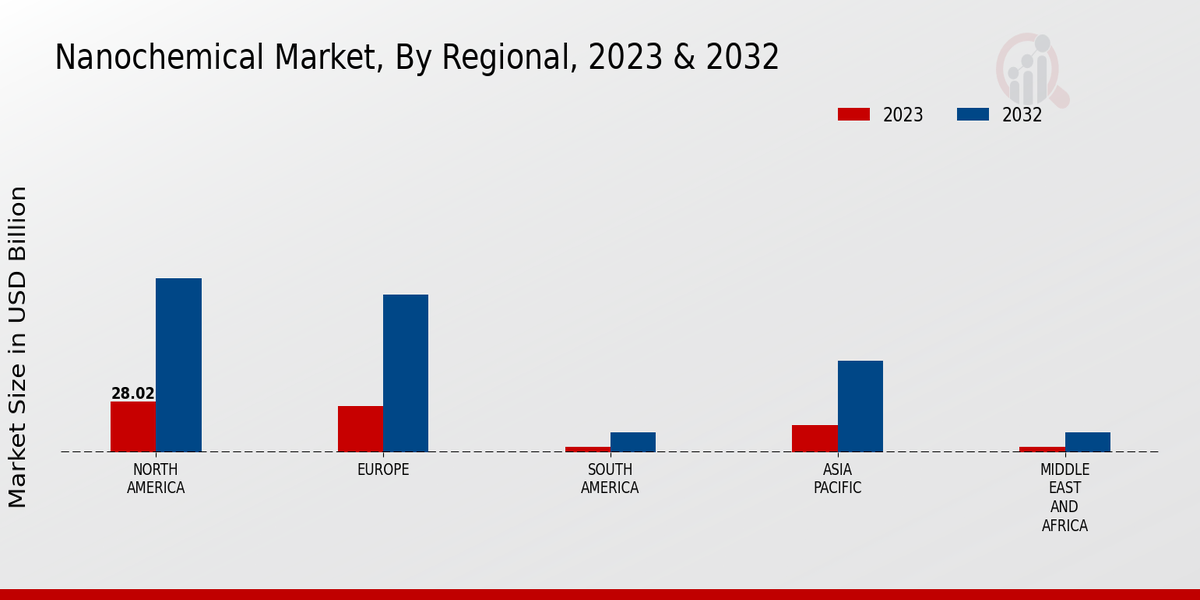Nanochemical Market Overview
Nanochemical Market Size was estimated at 64.82 (USD Billion) in 2022.The Nanochemical Industry is expected to grow from 74.32(USD Billion) in 2023 to 254.6 (USD Billion) by 2032. The nanochemical Market CAGR (growth rate) is expected to be around 14.66% during the forecast period (2024 - 2032).
Key nanochemical Market Trends Highlighted
Rising demand for advanced materials in sectors such as electronics, aerospace, and healthcare is driving the growth of the nanochemical market. Increasing investment in research and development is also fueling market expansion, as new applications for nanochemicals are constantly being discovered. The development of eco-friendly and sustainable nanochemicals is gaining traction, driven by the need for environmentally conscious solutions.The growing adoption of nanotechnology in various industries, such as manufacturing, energy, and pharmaceuticals, is creating significant opportunities in the nanochemical market.
Governments and organizations are also promoting the adoption of nanochemicals through funding and incentives, further boosting market growth. Recent trends include the integration of nanochemicals with other technologies, such as artificial intelligence and automation, which is enhancing their functionality and applications.

Source Primary Research, Secondary Research, MRFR Database and Analyst Review
Nanochemical Market Drivers
Increasing Demand for Nanomaterials in Electronics
The electronics industry is a major driver of the nanochemical market. Nanomaterials are used in a variety of electronic applications, including semiconductors, transistors, and capacitors. The increasing demand for electronic devices is driving the demand for nanomaterials, which in turn is driving the growth of the nanochemical market. Nanomaterials offer a number of advantages over traditional materials in electronic applications. They are smaller, lighter, and stronger than traditional materials, and they have unique electrical and thermal properties.These advantages make nanomaterials ideal for use in a variety of electronic applications, including Semiconductors. Nanomaterials can be used to create semiconductors with improved performance and efficiency. Transistors Nanomaterials can be used to create transistors that are smaller, faster, and more energy-efficient than traditional transistors. Capacitors Nanomaterials can be used to create capacitors with higher capacitance and lower leakage current than traditional capacitors. The increasing demand for electronic devices is expected to continue to drive the growth of the nanochemical market.As more and more electronic devices are produced, the demand for nanomaterials will also increase.
Growing Use of Nanomaterials in Biomedical Applications
The biomedical industry is another major driver of the nanochemical market. Nanomaterials are used in a variety of biomedical applications, including drug delivery, tissue engineering, and diagnostics. The growing demand for nanomaterials in biomedical applications is driving the growth of the nanochemical market. Nanomaterials offer a number of advantages over traditional materials in biomedical applications. They are biocompatible, meaning that they can be safely used in the body.They are also able to deliver drugs and other therapeutic agents to specific targets in the body. This makes them ideal for use in a variety of biomedical applications, including Drug delivery Nanomaterials can be used to deliver drugs to specific targets in the body. This can improve the efficacy of drugs and reduce side effects. Tissue engineering Nanomaterials can be used to create scaffolds for tissue engineering. These scaffolds can be used to grow new tissue and repair damaged tissue.Diagnostics Nanomaterials can be used to develop new diagnostic tools. These tools can be used to detect diseases earlier and more accurately.The growing demand for nanomaterials in biomedical applications is expected to continue to drive the growth of the nanochemical market. As more and more biomedical applications are developed, the demand for nanomaterials will also increase.
Government Support for Nanochemical Research and Development
Governments around the world are providing support for nanochemical research and development. This support is driven by the belief that nanotechnology has the potential to revolutionize a wide range of industries, including the electronics, biomedical, and energy industries. Government support for nanochemical research and development takes a variety of forms, including Funding for research and development projects, Tax breaks for companies that invest in nanotechnology, Creation of nanotechnology research centers Development of nanotechnology standards support for research and development is helping to accelerate the development of new nanomaterials and nanotechnologies.This is expected to lead to the growth of the nanochemical market in the coming years.
Nanochemical Market Segment Insights
Nanochemical Market Application Insights
The application segment plays a crucial role in shaping the dynamics of the Nanochemical Market. Among the key applications, Energy Storage is projected to witness substantial growth, driven by the increasing demand for efficient and sustainable energy solutions. In 2023, the Nanochemical Market revenue for Energy Storage is estimated to be around USD 12.693 billion, and it is anticipated to reach USD 46.409 billion by 2032, growing at a CAGR of 10.2%. Electronics is another significant application segment where nanochemicals are utilized in various components, including transistors, capacitors, and batteries.The Nanochemical Market segmentation for Electronics is expected to reach USD 55.53 billion by 2032, expanding at a CAGR of 9.8%. Coatings represent a promising application segment driven by the rising demand for advanced materials with enhanced properties. The Nanochemical Market data for Coatings is projected to grow from USD 10.271 billion in 2023 to USD 37.288 billion in 2032, exhibiting a CAGR of 10.5%. Healthcare is a rapidly growing application segment where nanochemicals are employed in drug delivery systems, medical imaging, and tissue engineering.The Nanochemical Market Statistics for Healthcare is anticipated to reach USD 82.759 billion by 2032, expanding at a CAGR of 11.2%. Automotive is another notable application segment where nanochemicals are used in lightweight materials, coatings, and sensors. The Nanochemical Market industry for Automotive is projected to grow from USD 8.852 billion in 2023 to USD 32.594 billion in 2032, exhibiting a CAGR of 9.9%. Overall, the Nanochemical Market growth is driven by the increasing adoption of nanochemicals across diverse industries seeking improved performance, efficiency, and sustainability.
Source Primary Research, Secondary Research, MRFR Database and Analyst Review
Nanochemical Market Material Type Insights
The Material Type segment of the Nanochemical Market is expected to witness significant growth in the coming years. Carbon Nanotubes, with their exceptional strength and electrical conductivity, are projected to dominate the market, accounting for a revenue of USD 18.2 billion by 2024. Graphene, another key material, is gaining traction due to its unique properties, such as high thermal conductivity and flexibility. It is estimated to reach a market value of USD 12.5 billion by 2024. Nanoparticles, including metal and semiconductor nanoparticles, are also expected to contribute significantly to the market growth, with a projected revenue of USD 10.8 billion by 2024.Quantum Dots and Nanocrystals, with their applications in optoelectronics and bioimaging, are anticipated to grow at a steady pace, contributing to the overall market expansion.
Nanochemical Market Properties Insights
The Nanochemical Market segmentation by properties offers crucial insights into the diverse applications and characteristics of nanomaterials. Electrical Conductivity plays a significant role in the electronics industry, enabling the development of high-performance batteries, semiconductors, and energy-efficient devices. Thermal Conductivity is vital for thermal management applications such as heat dissipation in electronic devices and industrial processes. Optical Properties, including transparency, refractive index, and light absorption, are essential for optical devices, sensors, and displays.Magnetic Properties find applications in magnetic storage, sensors, and medical diagnostics. Mechanical Properties, such as strength, toughness, and flexibility, are crucial for advanced materials in sectors like aerospace, automotive, and construction. This growth is driven by the increasing demand for nanomaterials in various industries, including electronics, healthcare, energy, and manufacturing.
Nanochemical Market Regional Insights
The Nanochemical Market segmentation by Region comprises North America, Europe, Asia-Pacific, South America, and Middle East Africa. North America is expected to hold the largest market share due to the presence of major nanochemical manufacturers and research institutions in the region, with a value of 28.019 billion USD in 2023 and projected to reach 95.692 billion USD by 2032. Europe is also a significant market for nanochemicals, with a value of 25.404 billion USD in 2023 and projected to reach 86.648 billion USD by 2032, driven by the growing demand for advanced materials in various industries. The Asia-Pacific region is expected to witness the fastest growth in the nanochemical market, with a value of 14.67 billion USD in 2023 and projected to reach 50.241 billion USD by 2032, owing to the increasing adoption of nanotechnology in various applications, such as electronics, healthcare, and energy.South America is expected to have a market share of 3.113 billion USD in 2023 and 11.121 billion USD by 2032, while Middle East Africa is expected to have a relatively smaller market share of 3.113 billion USD in 2023 and 10.877 billion USD by 2032 in the coming years.

Source Primary Research, Secondary Research, MRFR Database and Analyst Review
Nanochemical Market Key Players And Competitive Insights
Major players in the Nanochemical Market industry are continuously investing in research and development activities to enhance their product portfolio and gain a competitive edge. Leading Nanochemical Market players are forming strategic partnerships and collaborations with other companies to expand their market reach and improve their technological capabilities. The Nanochemical Market development is driven by increasing demand for advanced materials in various industries, such as electronics, healthcare, and automotive. Furthermore, government initiatives and regulations supporting the use of nanomaterials are also contributing to the growth of the Nanochemical Market. The Nanochemical Market Competitive Landscape is expected to remain competitive in the future, with new entrants and established players constantly vying for market share.Among the leading companies in the Nanochemical Market, Dupont is a prominent player with a strong focus on innovation and sustainability. The company offers a wide range of nanomaterials, including metal oxides, carbon nanotubes, and graphene. Dupont has a presence and serves a diverse customer base across various industries. The company's commitment to research and development has enabled it to develop advanced nanomaterials with unique properties and applications.A notable competitor in the Nanochemical Market is Evonik. The company specializes in the production of specialty chemicals, including nanomaterials. Evonik offers a portfolio of nanomaterials, such as silica, metal oxides, and polymers. The company has a strong presence in Europe and Asia-Pacific and is actively expanding its operations in other regions. Evonik's focus on innovation and customer-centric approach has allowed it to gain a significant market share in the nanochemical industry.
Key Companies in the Nanochemical Market Include
- Solvay
- NANOMATERIALS TECHNOLOG
- Applied Nanotech Holdings
- Merck
- Nanoshel
- Nanosys
- Evonik Industries
- SigmaAldrich
- DuPont
- Nanoco Group
- Cabot Corporation
- Nanosphere Health Sciences
- BASF SENewparaDow Chemical
Nanochemical Market Industry Developments
The nanochemical market is projected to reach USD 254.6 billion by 2032, exhibiting a CAGR of 14.66% from 2024 to 2032. The increasing demand for nanochemicals in various end-use industries, such as electronics, healthcare, and energy, is driving market growth. Advancements in nanotechnology and government initiatives to support research and development are further propelling the market forward. Key market players are focusing on strategic collaborations, acquisitions, and new product development to enhance their market position. Recent developments include BASF's expansion of its nano additives production capacity and Evonik's acquisition of Structured Polymers, a leading manufacturer of nanostructured materials.
Nanochemical Market Segmentation Insights
Nanochemical Market Application Outlook
- Energy Storage
- Electronics
- Coatings
- Healthcare
- Automotive
Nanochemical Market Material Type Outlook
- Carbon Nanotubes
- Graphene
- Nanoparticles
- Quantum Dots
- Nanocrystals
Nanochemical Market Properties Outlook
- Electrical Conductivity
- Thermal Conductivity
- Optical Properties
- Magnetic Properties
- Mechanical Properties
Nanochemical Market Regional Outlook
- North America
- Europe
- South America
- Asia Pacific
- Middle East and Africa
Nanochemical Market Report Scope
| Report Attribute/Metric |
Details |
| Market Size 2022 |
64.82(USD Billion) |
| Market Size 2023 |
74.32(USD Billion) |
| Market Size 2032 |
254.6(USD Billion) |
| Compound Annual Growth Rate (CAGR) |
14.66% (2024 - 2032) |
| Report Coverage |
Revenue Forecast, Competitive Landscape, Growth Factors, and Trends |
| Base Year |
2023 |
| Market Forecast Period |
2024 - 2032 |
| Historical Data |
2019 - 2023 |
| Market Forecast Units |
USD Billion |
| Key Companies Profiled |
Solvay, NANOMATERIALS TECHNOLOG, Applied Nanotech Holdings, Merck, Nanoshel, Nanosys, Evonik Industries, SigmaAldrich, DuPont, Nanoco Group, Cabot Corporation, Nanosphere Health Sciences, BASF SENewparaDow Chemical |
| Segments Covered |
Application, Material Type, Properties, Regional |
| Key Market Opportunities |
Energy storage Drug delivery Electronics Construction Healthcare |
| Key Market Dynamics |
Rising demand in electronics increasing investment in RampD growth in the healthcare industry environmental regulations and advancements in nanotechnology |
| Countries Covered |
North America, Europe, APAC, South America, MEA |
Frequently Asked Questions (FAQ) :
The Nanochemical Market is anticipated to reach a valuation of 74.32 billion USD in 2023.
Nanochemical Market is projected to expand at a CAGR of 14.66% from 2024 to 2032.
North America is anticipated to dominate the Nanochemical Market in 2023.
Major application segments include electronics, healthcare, energy, and environmental protection.
Key competitors in the market include BASF, Evonik, and Solvay.
The Nanochemical Market is estimated to reach a valuation of 254.6 billion USD by 2032.
The electronics industry is expected to be a major driver of demand for nanochemicals.
Challenges include regulatory concerns and the need for specialized infrastructure.
The Asia-Pacific region is anticipated to experience significant growth due to increasing demand from emerging economies.
Factors driving adoption include advancements in nanotechnology and growing awareness of their benefits.





























